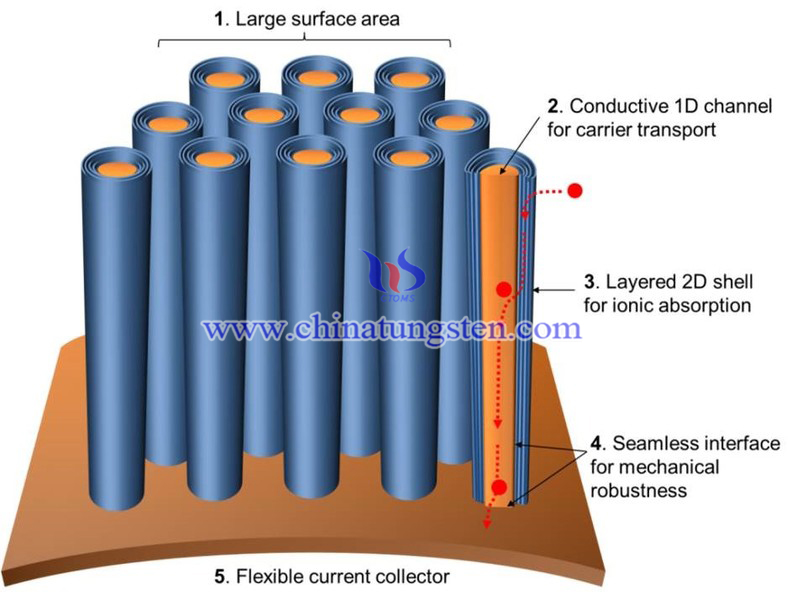Tungsten Oxide Nanowire Supercapacitors as a Great Alternative to Lithium-ion Battery
- Details
- Category: Tungsten's News
- Published on Monday, 16 July 2018 17:47
- Written by yuntao
- Hits: 600
A lithium-ion battery or Li-ion battery is a type of rechargeable battery in which lithium ions move from the negative electrode to the positive electrode during discharge and back when charging. With the development of technology, the application of lithium-ion batteries are everywhere in our lives, such as smart phones, tablets, laptops, game controllers, cordless power tools, beauty products, digital cameras, video cameras, cars, etc.
Lithium-ion batteries are everywhere. However, they also have their own shortcomings. Their charging time and safety performance have always been a topic of concern. Therefore, scientists have been looking for alternatives to lithium-ion batteries. One possible alternative is what we called “supercapacitor”.
Unlike lithium-ion batteries that store energy through chemical processes, super capacitors rely on static electricity to store energy. A simple example is, when you take your clothes out of the dryer, generally they will stick together. That is the force of static electricity. And supercapacitors can absorb and store this sort of electricity. Speaking of this, you might think of one possible application of supercapacitor. Actually, it can be used as the power of a hybrid car. When electric energy is generating during braking or driving, it can be absorbed and stored by super capacitors, and then reused in the power system of the car. Those super properties of a supercapacitor make it a great choice to be the power supply of a hybrid car.
A superapacitor has some significant advantages over batteries as an energy storage device. For example, they have a higher speed of charging and discharging. They are lighter in weight and has a longer service life. They are also non-toxic and safe to use. Supercapacitors have capacitance values much higher than other capacitors (but lower voltage limits) that bridge the gap between electrolytic capacitors and rechargeable batteries. In addition, supercapacitors are also characterized by high efficiency and long cycle life. In the future, it has broad possibilities of applications in electric vehicles, information and communication, aerospace and military.
But the manufacture of large-capacity supercapacitors is not that easy. Thanks to the advancement of nanotechnology, more and more new materials have been invented. For example, researchers at the University of Florida have developed a supercapacitor made of tungsten oxide nanowires. The nanowires is made up of a two-dimensional shell (highly monocrystalline tungsten trioxide) wrapped by a one-dimensional core (tungsten sulfide).
Tungsten oxide nanowires are one-dimensional materials. Due to the reduction of material dimensions and structural feature size. One-dimensional nanomaterials have a more novel physical and chemical properties in electricity, magnetism, light, and heat. and therefore, tungsten oxide nanowires have a larger specific surface area than conventional tungsten oxide materials. These nanowire supercapacitors solve the size problem. At least one dimension of the nanoscale material is less than about 100 nanometers, which is about 100,000 times smaller than the diameter of a human hair. You can put millions of nanowires into the same volume occupied by lithium-ion batteries in your phone.
Therefore, the combination of millions of tungsten oxide nanowires makes a supercapacitor. And its performance makes it an ideal replacement for lithium-ion batteries. For example, they can be charged and discharged very fast. The scientists who successfully synthesize tungsten oxide nanowires believe that the new supercapacitors have a very quick charge speed. So the electronic devices equipped with tungsten oxide nanowire supercapacitors can be charged in a matter of seconds. And its power can sustain for more than one week of normal use. The quick discharge rate will make cars equipped with tungsten oxide nanowire supercapacitors have a higher acceleration than the one equipped with lithium-ion batteries.
Another advantage is that nanowire supercapacitors has a longer lifetime than lithium-ion batteries. A common lithium-ion battery lasts 1,000 to 1,500 charge cycles. After the battery capacity has degraded to 50% of the original battery capacity. You have to charge it twice to make a charging cycle. However, tungsten oxide nanowire supercapacitors will not degrade even after 30,000 charge cycles. What’s more, tungsten oxide nanowire supercapacitors can be used on flexible substrates. They be molded into the desired shape or incorporated into wearable devices and detachable flexible film phones. In conclusion, it is believed that tungsten oxide nanowire supercapacitors have a broad application prospects in the future.
- Tungsten Manufacturer & Supplier, Chinatungsten Online: www.chinatungsten.com
- Tungsten News & Prices of China Tungsten Industry Association: www.ctia.com.cn
- Molybdenum News & Price: news.molybdenum.com.cn
- Tel.: 86 592 5129696; Fax: 86 592 5129797; Email: sales@chinatungsten.com





 sales@chinatungsten.com
sales@chinatungsten.com